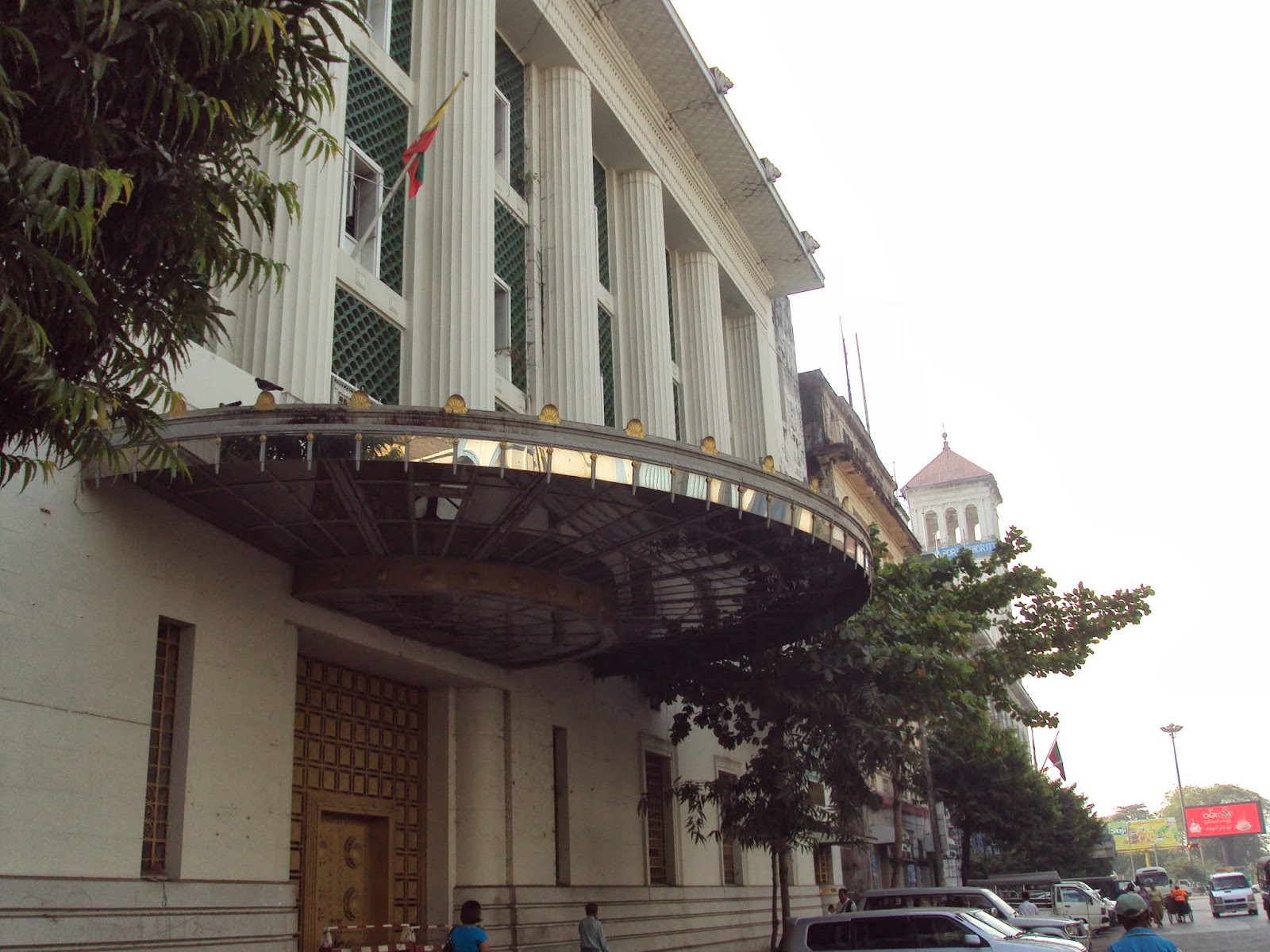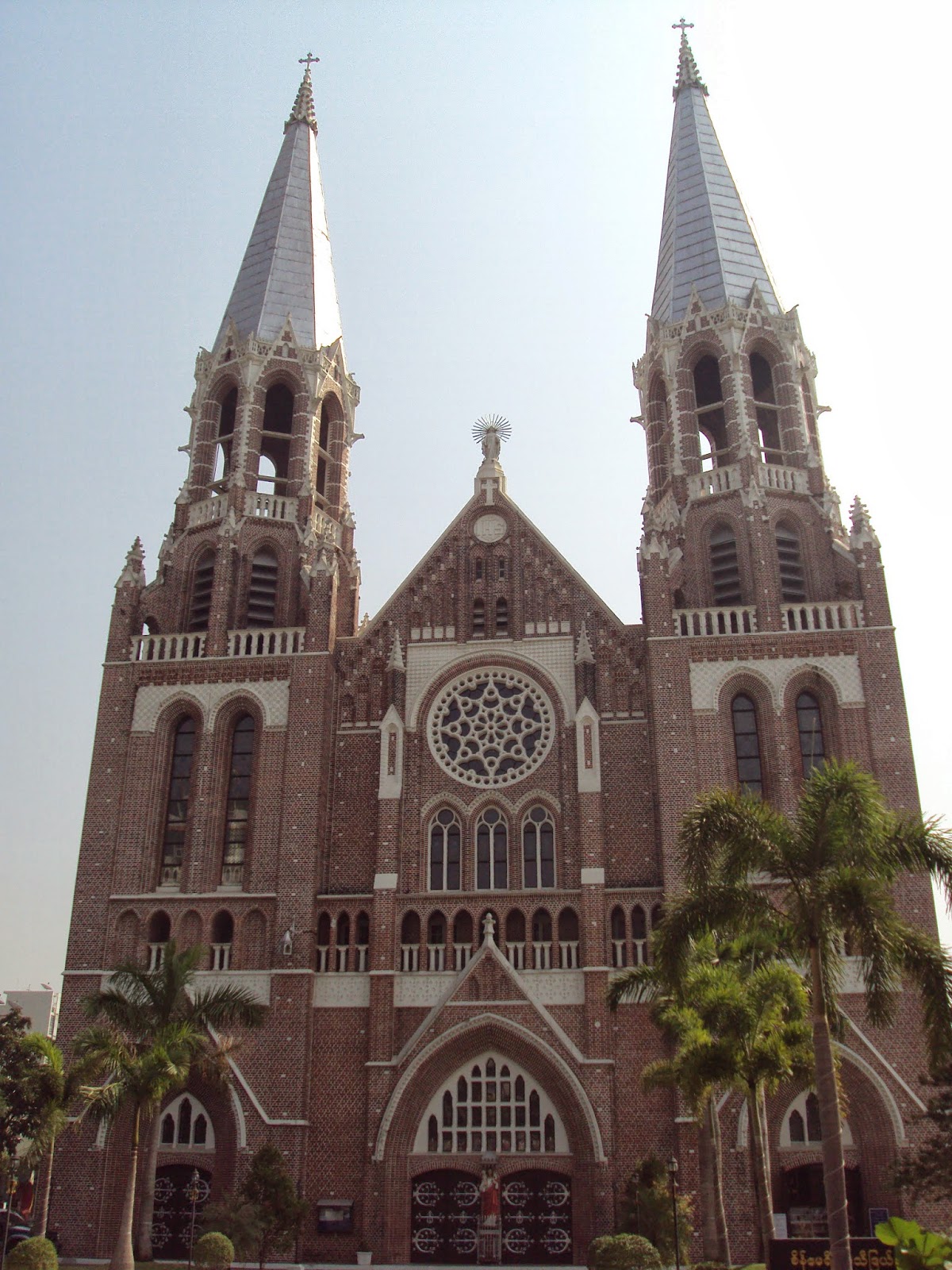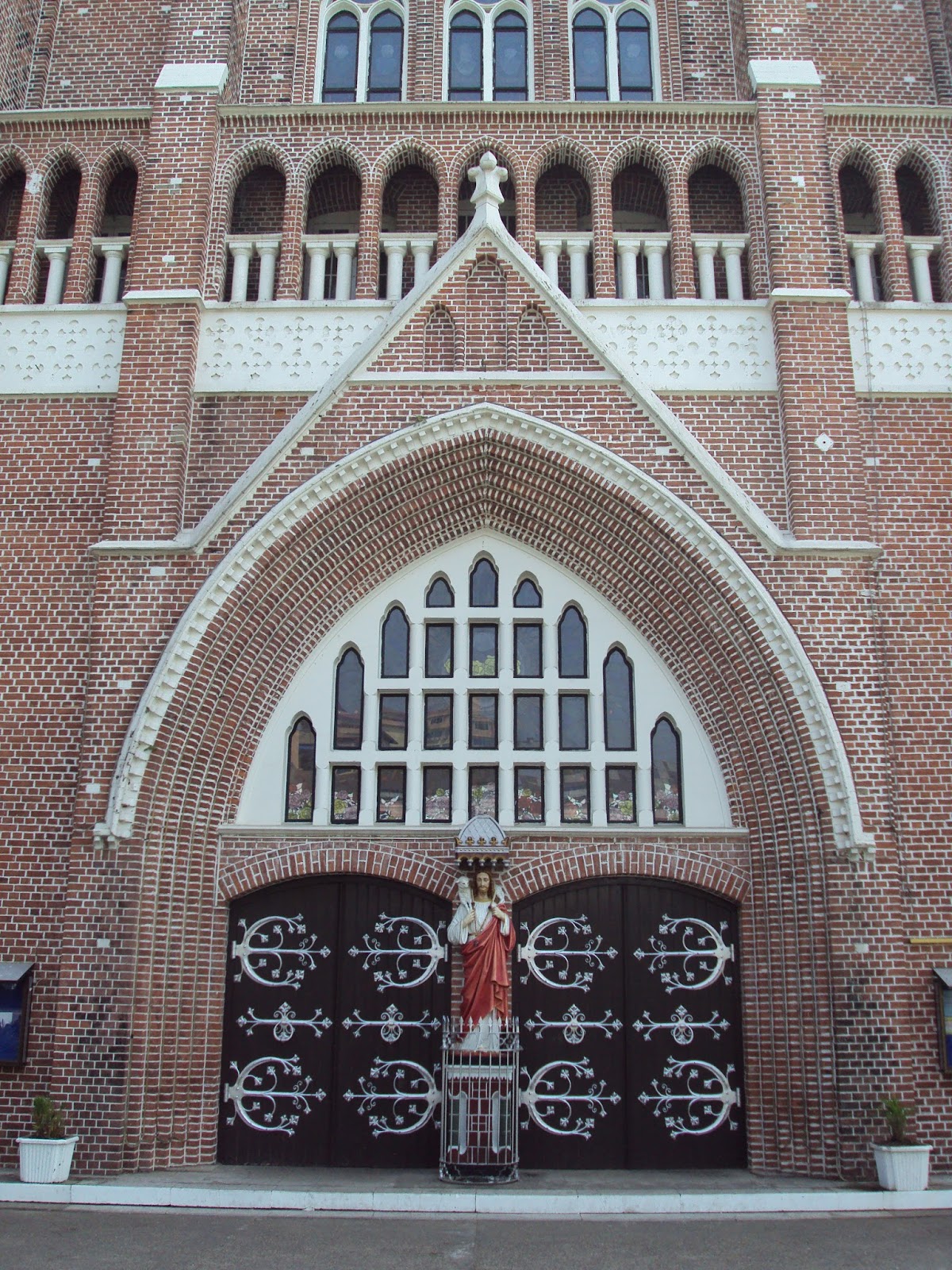 |
| Irrawaddy Chambers, Pansodan St, Rangoon |
Rangoon surprised me as I gaped up in awe. Stories I read ranked Rangoon
highly, an equal to London and other great cities of Empire at her height. Then
she fell in to obscurity, with her country’s troubled past and arguably present
casting a shroud over her.
 |
| Turn of the century architecture, Pansodan St, Rangoon |
And it is this shroud that has protected Rangoon, in more ways than one.
Walking along Merchant St, the beautiful colonial splendor of merchants and
their edifices to wealth, power and influence served as a stark reminder, if
not a monument to their memory.
 |
| Pansodan St towards the Strand, Rangoon |
Along Pansodan Street, buildings with architecture that equal the splendor
of colonial Singapore and Hong Kong stand side by side, in close proximity,
almost daring the other to show who is the more powerful. Ionic, Doric and
Corinthian-order columns decorate the façade, with a small show of a
Dutch-inspired domed-copula building as a reminder of who else was active in the
region then.
 |
| Water Transport Ministry Building, Pansodan St, Rangoon |
Even Customs House has a decidedly Dominion-feel to her, and would not
look out of place in New South Wales or Victoria. Her red brick and white
columns provide a stark yet delightful contrast and interplay, a motive repeated
from the church to the courts.
 |
| Custom House, the Strand, Rangoon |
Finally, after a rather large detour, my lunch became brunch, and a slightly
late one while we’re at it. I decided for breakfast at the Strand, having been
informed and read that The Strand Rangoon is one of four great hotels in Southeast
Asia during the colonial period built by the famous Sarkies Brothers.
Having been to their flagship E&O Hotel in Penang and Raffles Hotel in
Singapore, it seemed apt for me to visit and cross another of their properties
of my list. Which now leaves the Hotel Orange, now the Hotel Majapahit in
Surabaya. It was only here did I have expectations, one which did not quite cut
to the mark.
 |
| Main Porch, The Strand Hotel, Rangoon |
The E&O and Raffles were grand, stately hotels, taking up their own
city block in their own right, with an expansive ground and elegant façade.
This property of the Sarkies Brothers was somewhat smaller than the others, and
did not exude the same feel of elegance and opulence but instead had a tinge of
understated luxury, albeit one that needed a makeover.
 |
| Reception area, The Strand Hotel, Rangoon |
The interiors felt a bit small, the flooring and tiles somehow had the
feel as if they were replaced rather than faithfully reproduced and maintained.
Regardless, it was a nice hotel, and their croissants were very good.
 |
| The Strand Cafe, The Strand Hotel, Rangoon |
With breakfast in hand, I decided to further my walk, map in hand, to
find the old Minister’s Office and St Mary’s Cathedral. Walking down from The
Strand along the Strand, next door was the Australian Embassy, in a beautifully
appointed townhouse, with the British Embassy in the next block along the
Strand.
 |
| Australian Embassy, Rangoon |
Making a turn along Bo Aung Kyaw St, I found the great albeit very
forlorn Minister’s Office, located at the junction of Bo Aung Kyaw and Bogalay
Zay St. This great building, built by the British, almost in the style of grand
New Delhi, was to be the headquarters of the Government of British Burma, and
they built it well to signify their majesty and imperiousness.
 |
| Minster's Office, Rangoon, Main Facade |
 |
| Minister's Office, Rangoon |
It somehow felt like its own commentary, when now this monument to
imperial power is now abandoned, with the building boarded up, windows missing
and unkept surrounds. The building was meant to be a museum, and some work was
seen when I visited, but it still felt like a very sad commentary on shifts in
power.
 |
| Main Building, St Paul's School, Rangoon |
 |
| St Paul's School, with St Mary's Cathedral's spires |
At the northern edge of the Minister’s Office compound, along Anawratha
Rd is the St Paul’s School building, a rather impressive looking school block
with Elizabethan accents yet shares a similar colour scheme to St John’s
Institution in Kuala Lumpur. The white spires of the cathedral poked up in the
skyline, but I felt like doing a circuit around what I suspected is the Roman
Catholic compound to see what else lies around it.
 |
| Building, Thein Phyu Rd |
Taking a left at the junction of Thein Phyu and Anawratha Rd, I chanced upon
a beautiful red bricked with white accents building, and within the Roman
Catholic compound, the Archbishop’s Residence. It was here did the surprises
really start.
 |
| Archbishop's House, Rangoon |
It is called the venerable Archbishop’s House, but should rather be named
Archbishop’s Palace. The high walls did little to hide the three storey
edifice, a beautiful Italianate structure with a very practical high roof
perfect for the tropics. The leafy gardens and beautiful grounds only heighten
the sense of arrival to the cathedral, as the spires and towers gleam overhead.
 |
| St Mary's Cathedral, Rangoon |
And there it was, in all her glory. It was an impressive church building.
The French did their best in Saigon, with my personal favourite being St Philip
the Apostle Church with her pastel colours and French-Gothic spire and
architecture. The Spanish went with ‘frequency’ of churches as opposed to
British ‘consolidation.’ The Dutch went with the familiar. In this instance,
the British, or more specifically the Roman Catholics, perhaps to outdo the
Anglicans down the road on the other side of town with their edifice, went with
‘shock and awe.’
 |
| St Mary's Cathedral, Rangoon |
Shocked and awed I was. And disappointed I became when the gate was
closed and wouldn’t budge. There I was, the crux of my travels, of my venture
to seek out the ecclesiastical heritage of Southeast Asia, and I was stopped by
a gate that would not budge.
I said out a small prayer, requesting, if only, to visit this monument
built to the glory of God. Just as I thought all hope was lost, out of the
blue, someone appeared from within the church and opened the gate. There he
was, a simple parishioner, but to me, he was literally the answer to my prayer.
Providence works in mysterious ways.
 |
| Great Door, St Mary's Cathedral, Rangoon |
If the architecture outside did not awe, then the interior would surely
put you to heel. From the outside, the sheer detail and scale kept with French
Gothic lines; grand yet not imposing. The interior though, caused you to soar.
 |
| Facing apse, St Mary's Cathedral, Rangoon |
Unlike other cathedrals of this order, there was no dark stone. Here was
a riot of colour, with the red and white motif seen almost everywhere else in
Rangoon present and prominent here. The vaulted ceiling highlighted by the
interplay of dark against light, the stained glass windows adding further
dimensions and the numerous stations of the cross and relief of the lives of
the saints were not only carved in marble, they were coloured.
 |
| Stained Glass, St Mary's Cathedral, Rangoon |
Niches were filled with statuary, complementing the lower panel with the
carved ‘scenes’ and stained glass window in between. This was not a drab, somber
church building: this was a celebration of colour, architecture and art.
 |
| Niches, St Mary's Cathedral, Rangoon |
This was and is a fitting end to my journey, both of my first
exploration of Burma and Rangoon, but also a fitting end to my personal
project, a quest to seek out the great church buildings of the colonial age.
But there was one thing I somehow had to do. I had to see The Lady.
So, on my last day, heading to the airport, I asked my driver if we
could pass her house. He was more than happy to oblige. Revealing his hopes and
dreams shared with The Lady, we arrived at her house along University Avenue,
along the shores of Inya Lake.
Next door, the American Embassy grounds were massive, apparently the
largest in Southeast Asia. Daw Aung San
Suu Kyi’s house was surrounded by a high brick wall with barbed wire, but
unguarded except for a guard house by the main gate.
 |
| Party Banner, Aung San Suu Kyi's House |
Sadly, I could not have afternoon tea with her: she spends weekdays in
Naypyitaw and weekends in Yangon. Just as I was taking pictures and soaking in
the atmosphere amidst rush hour traffic along a major road, another taxi with a
middle aged couple stopped, and they also took pictures.
 |
| Main Gate, Aung San Suu Kyi's House |
We acknowledged one another and expressed disappointment that The Lady
was not around. Then as we took pictures, the guy commented, and I wholeheartedly agree: “We just have to do it!”

No comments:
Post a Comment